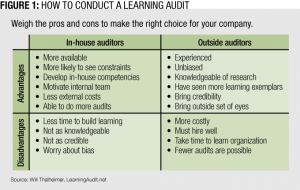 Just like most trends that once worked, an organization’s learning strategies are bound to go out of style at some point. It is a CLO’s job to recognize when current learning and development strategies no longer yield the same successful results.
Just like most trends that once worked, an organization’s learning strategies are bound to go out of style at some point. It is a CLO’s job to recognize when current learning and development strategies no longer yield the same successful results.
To do this, learning leaders need to look deep within their organizations. They need to review programs often, be aware of the strengths and weaknesses in their learning strategies, and implement changes accordingly. The best way to do that is to conduct a learning audit.
Diana Thomas, former learning executive at McDonald’s Corp. and current CEO of learning consultancy Winning Results LLC, said a learning audit is “a way to really step back and do a 360 and look at your whole organization.” It’s a way to examine where an organization is currently, and what sort of progress it needs to make in the future. But to reap a learning audit’s full benefits, CLOs must be intimately familiar with all learning objectives, delivery modalities and post-implementation processes.
Take Your Pick
A learning audit can provide significant information to help CLOs understand their organization’s current levels of productivity, engagement, knowledge and success, as well as how to improve these for the future.
Timo Sandritter, HR strategist and chief operation officer for digital media group Haufe Inc., said frequent audits will answer questions like: Are employees up to date on training needs/wants? Is the company emphasizing moving the entire ecosystem forward as a unit or only for select individuals? How does individual development progression reflect on the organization’s ability to attract and retain talent? Investigating these key factors allows learning leaders to understand how their development strategies are currently functioning and how they can be improved. Further, employee learning and development can become stagnant when the organization is not experiencing growth. Sandritter said a learning audit can help a CLO avoid this undesirable state.
 By conducting a learning audit, CLOs are not only investing in their employees, they’re investing in themselves. “It gives the learning leader so much credibility for being a strategic leader, anticipating where the company needs to go and ensuring that your learning organization aligns,” Thomas said.
By conducting a learning audit, CLOs are not only investing in their employees, they’re investing in themselves. “It gives the learning leader so much credibility for being a strategic leader, anticipating where the company needs to go and ensuring that your learning organization aligns,” Thomas said.
Learning audits can uncover useful information and increase a learning leader’s credibility, but many forgo them because the audits appear too intimidating. But there are a variety of audits available, so learning leaders can customize their audit experience and eliminate the fear associated with the process.
According to William Thalheimer, president of Work-Learning Research Inc., choosing between a variety of learning audits allows the CLO to personalize how best to use their resources and budget to meet learning-driven business goals. Audits can be full scale, or smaller and less-time consuming; focused on inputs or outputs; conducted by an internal or an external auditor. For example, an organization that relies on a short e-learning program might be able to perform a small-scale learning audit and still receive sufficient information to improve the program. On the other hand, investigating classroom learning tends to require a more extensive audit.
After evaluating which type of learning audit best meets an organization’s needs, the CLO has to determine what delivery modalities it needs. Sandritter said “one size does not fit all” when it comes to specific delivery modalities.
Thomas, who conducted an intense learning audit while at McDonald’s, shared a similar piece of advice; there is no “secret formula” for conducting an audit. For McDonald’s, Thomas and her team began by examining employees’ education levels, gender, ethnicity in regards to language, age and generation. This data is important to thoroughly understand the learning audience — the people using the learning curriculum.
In addition to examining demographics, Thomas conducted a thorough content analysis. Asking questions such as: What are people thinking? Are they thinking that the training’s accessible? That it’s easy to find? Do they like the content? Are they using the content?
Finally, McDonald’s learning audit examined employee job profiles. This revealed the responsibilities, tasks and leadership skills associated with each job to ensure the core curriculum supported them.
The main objectives for the McDonald’s audit were to understand the audience, become aware of their perspectives and tailor learning content to meet the audience’s needs. But learning audits can examine other aspects of an organization, such as the amount of content provided in addition to the content type.
Too many learning leaders teach too much content, said Thalheimer. “If you teach content and that’s your focus, you tend to lecture, you tend to put information out there, but you forget to do things like encouraging learners to reflect, to think about how it’s relevant, to give them decision-making practice, to give them repetitions in learning.”
Thalheimer said learning leaders also may not support learner retention; teaching content is useless if it is quickly and easily forgotten. Simulations are one way to combat this issue, as are learning strategies that require learners to retrieve things from their memory in the same way they have to on the job, along with spacing out repetitions of key learning points over time.
Audit Complete. Now What?
After identifying the strengths and weaknesses in an organization’s learning strategies, Sandritter said the company has to adapt and adjust. “Audits are only as good as the actions taken afterwards,” he said. “Therefore, CLOs should have audit plans in place that include specific action items, time frames and stakeholders involved.” Involving stakeholders in the audit process from the beginning is important so that all of the most important decision-makers are on the same page, and there are no surprise disagreements to delay the process.
Thalheimer, who has conducted many learning audits for various organizations including the Navy SEALs, said to successfully turn a learning audit’s results into organizational change, the key is level-setting. Level-setting is a two- to three-hour process that occurs before the audit results are revealed. During this process, learning leaders and stakeholders familiarize themselves with research-based best practices to understand how their findings compare to the research and then implement changes accordingly.
Thomas examined the results of the McDonald’s audit and implemented changes to the learning curriculum that directly impacted the three main objectives she identified in the preliminary audit stages. The audit results revealed that learners were shifting in regards to education and gender. Further, learners were coming from younger generations, but the learning curriculum was not meeting their employees’ needs sufficiently.
So, Thomas and her team created a curriculum comprised of more absorbable chunks. They shortened the curriculum to retain learners’ attention, using technology that made the curriculum more accessible, and they created more learning options within the curriculum. For instance, learners often read faster than the audio playback; it helped to have text available and to be able to turn the audio off.
A learning audit can shed light on new information as well as reinforce previous assumptions. Either way, the information revealed provides learning leaders with crucial knowledge they need about their organization in order to create better learning and development options.
But Is It Worth It?
Audits can be a lot of work, and some learning leaders may ask themselves, Is it worth it? The answer is, absolutely.
The benefits of conducting a learning audit are often much greater than the cost. Further, the CLO can decide how often they want to conduct one. More exhaustive and comprehensive audits won’t need to be conducted as often, but smaller, less-expensive audits could be used once or twice a year. Sandritter said CLOs should periodically examine their learning strategies in order to adapt to the constantly changing demands of their respective markets.
Thomas said she would prioritize a learning audit over other organizational investments. “At the end of the day, you want to do whatever is best to help improve and increase the results of your organization.” Conducting a learning audit is the best way to ensure that learning leaders and CLOs do just that.
AnnMarie Kuzel is a former Chief Learning Officer editorial intern. To comment, email CLOmedia.com.















